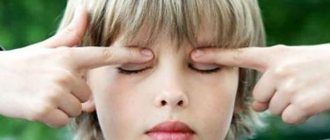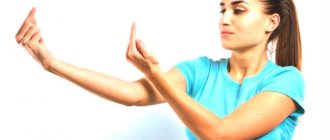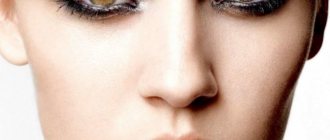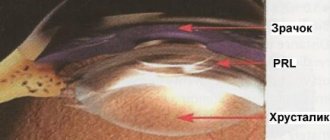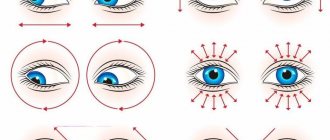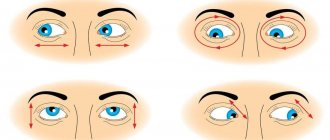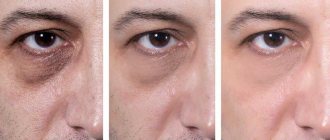Photophobia is dangerous!
A person is most active during the daytime, so the retina of the eye functions better in daylight. Due to the lack of sunlight, the retina gradually gets used to the new conditions and becomes very sensitive to normal daylight. Such eye hypersensitivity to light is a disorder and dysfunction of the visual system.
The degree of photophobia can manifest itself in mild squinting in direct sunlight to serious diseases that force a person to wear sunglasses constantly. In any case, photophobia is an acquired disorder, not a congenital one. The cause of its occurrence may be a long stay in enclosed spaces.
Photophobia can be overcome, then the eyes will get rid of tension, and this will restore vision.
What is the essence of the treatment technique?
During cloudy periods, you can use a regular incandescent lamp with a power of 150-200 W. But IR and color lighting are contraindicated.
The treatment method of ophthalmologist Bates is based on the effect of sunlight on the retina of the eye. The procedure is recommended to be carried out 1-2 times a day for 2-3 months to improve visual acuity. When wearing glasses, you should gradually get used to sunlight. Restorative gymnastics, when strictly following the technique, gives the following effects:
- improvement of accommodative abilities;
- acceleration of blood flow;
- normalization of eye nutrition;
- maintaining muscle tone;
- improving visual abilities in the dark.
How to do solarization for eyes?
It is better to start with sunbathing for half a minute. Then cover your eyes with your palms until the afterimages disappear; the cycle must be repeated two to three times. With each subsequent lesson, increase the time of sunbathing to 20 minutes.
If photophobia is very strong, you can look not at the sun, but at a bright part of the sky. Next time, turn closer to the sun - and continue this each time until the discomfort in the eyes under direct rays of the sun disappears. In cases where the brightness of the sky seems very strong, you can start with artificial light, moving the lamp closer to you until you prepare your eyes for solarization in sunlight.
Sessions can be carried out 2-3 times during the day. On cloudy days, the sun's rays can be replaced with artificial lighting; an ordinary household light bulb with a power of 150 watts is suitable for this, but the best effect will be from a lamp of one hundred watts with a reflector that has directional light. There is no need to use fluorescent, infrared or ultraviolet lamps when solarizing.
While doing the exercises, slowly turn your head so that the light is distributed evenly across the entire retina. The rotation angle should be slightly more than 90°, and the rotation time should be up to 10 seconds. You can change the movements, for example, “draw” a circle, an infinity sign, a figure eight or another geometric figure with your nose. In this case, change the movements to the opposite direction. During the solarization exercise, you should experience a state of pleasant drowsiness, which is induced by the heat entering through the eyelids. But if you feel discomfort, stop this exercise.
EXERCISE N 50
Having taken a starting position similar to that described in exercise No. 49, that is, sitting comfortably, you need to cover one eye, for example, the left one, with your palm cupped, so as to avoid pressure on the eyeball. Now, making small turns with your head and elbow from side to side (similar to that described in exercise N 47), look several times through the solar disk with your right eye. The right eye should blink continuously. Don't forget to take deep breaths while turning. Oddly enough, you will not experience any unpleasant sensations. Switch the roles of the eyes and do the same with the left eye. Such short glances at the sun while continuously blinking will not cause any harm to the eyes and will not cause any discomfort. Those spots of so-called sequential images that you will see for some time after solarization are quite common. They will quickly disappear after you palm for a while (which should be done immediately after solarization). After palming, expose your eyes to the sun again, but this time both together and with your eyelids closed. This solarization significantly strengthens the eyes. After some time, you will not be afraid of any blinding reflections from the snow, glare on the water or the light of car headlights. At the very least, they will irritate your eyes much less. You need to do this exercise 10 times if you are working with the sun and about 20 times if you use an electric lamp instead of the sun (with a lamp power of 150 watts). When performing this exercise, remember the following: never solarize (with your eyes open) both eyes at the same time; Never stare at the sun or light source continuously.
As you can see, the Bragg technique is quite similar in some of its elements to the solarization method proposed by M. Corbett. A somewhat unusual method of solarization is recommended by C. L. Thomson. Although it cannot be called solarization in the full sense of the word, it is close to it in essence and is an excellent preparatory exercise for direct, more energetic solarization.
Exercises for treating eyes with the sun
The main set of exercises is performed with eyes closed. At dawn and sunrise they look at the light source with their eyes open, and during daylight they look at the light bulb only with their eyes closed.
A few exercises in the afternoon sun:
- Turning your head with your eyes closed. Stand facing the sun and look first to the right, then to the left with your head turned (eyes closed). Repeat the exercise slowly up to 15-20 times.
- Train each eye separately. Find a shade that will expose one side of your face to the sun. Tilt your head to the right and left. The exercise is performed slowly up to twenty times. Then you need to change the position so that the other eye is in the sun and repeat the complex.
- Focus on the surface of the water. Looking at the bright daytime sun with your eyes open is harmful. Therefore, Bates solarization offers an exercise in focusing your gaze on any body of water. Focus on the reflection of the sun in the water for as long as you can without discomfort or discomfort in your eyes. Try to increase the time each time.
Exercises with an artificial light source also involve turning the head. Eyes must be closed. Choose a light bulb no larger than 150 watts, install it at a distance of about 100 cm from the eyes at head level.
Regular exercise improves vision and prevents eye diseases.
Exercises with a light source
The sun's ray gives us not only life, warmth, food. Decomposed into the colors of the spectrum, it gives us seven colors of the rainbow. It is no coincidence that the ancient tradition of worshiping light and fire is associated with the rainbow, the components of which have an effect on various human organs.
Sunlight is very important for the health of the visual system. The fact is that the daily curve of the spectral sensitivity of our eye (otherwise, the sensitivity of the eye to light rays of different colors), as a result of the centuries-long process of evolution of life on Earth, almost coincides with the average distribution curve of the energy of sunlight reflected and scattered by green plants; There is a certain “kinship” between the eye and the sun. It is clear that staring at the bright sun is harmful, although with training and precise fulfillment of a number of conditions, this exercise will bring health to the visual system. There are a number of exercises with light sources, and this is not only the sun, but also a candle flame, the light of the moon.
General rule: be aware of the particular anatomical parts of the eyes involved in the exercise.
Candle flame exercise
The exercise is usually performed in the evening, after sunset, in darkness or semi-darkness.
Place a lit candle at eye level or slightly higher, at a distance of 0.5 to 1 m from your face - whatever is more convenient for you. According to classical canons, this distance should be equal to the distance from the eyes to the pubis. Take a stable position and, without blinking, look at the candle. Nothing should distract you at this time - neither objects, nor sounds around, nor thoughts.
Peer carefully into the flame, gradually narrowing the area of vision to a minimum. Eyes open wide, try not to blink. The flame begins to turn into one bright spot, which will grow as the exercise continues. Ideally, the spot should occupy the entire field of view.
During the exercise, the head should be free of all extraneous thoughts. You need to learn to just look. This is the most difficult thing, and skill comes only after long training. Using central fixation, try to see something in the flame. Separate yourself from your thoughts, kindly evaluate everything as if from the outside.
During the first weeks you should look at the flame until your eyes get tired. In the future, this time can be increased to 10–15 minutes. It is strictly forbidden to do this exercise by force. Whenever pain and tears appear, you need to close your eyes and continue to look at the candle with your mind's eye until the light spot disappears. Each time you should try to increase the time of this residual glow and mentally see the flame as clearly as possible.
During the exercise, do not forget about posture! It is very important to keep your back and head straight at all times. If you find that your head is down and your back is bent, you should immediately straighten up.
Finish the exercise with calm, even breathing, then take a deep breath, hold your breath for 10 seconds, no more, exhale and relax your eyes. It is best to do palming.
Fixing your gaze on a candle flame for a long time has a beneficial effect on the eyes and improves visual acuity. Central fixation, or focusing your gaze on a reflected candle flame, is also effective, but it is recommended to start it after several months of performing the previous exercise.
Working with reflection
The technique for performing this exercise is similar, but fix your gaze not on the flame, but on its reflection in the water. To do this, place a basin, plate or wide bowl and pour water into it. The use of a mirror is not advisable. You need to look at an angle of about 30 degrees to the surface of the water. Fixing your gaze on reflected light improves the ability to concentrate attention and calms the nervous system.
Looking at the sun (solarization)
The exercise is performed in the morning or evening, when the sun touches the horizon, that is, approximately half an hour after sunrise or half an hour before sunset. You should not look closely at the bright sun during the day.
Take any stable position, straighten your back, keep your head straight. Direct your gaze towards the sun. Look carefully at the center of the sun, trying to reduce your field of view to the size of the solar disk. Look with your eyes wide open, without straining them or blinking.
When you feel like tears are about to come out, you should close your eyes and mentally hold the trace of the sun at the point between your eyebrows. The eyes remain relaxed.
If it turns out to be impossible for you to look at the sun, then fix your gaze in the space next to the sun, gradually bringing it closer to the disk. With long endurance, it is better to repeat the exercise several times than to prolong it by force.
Just like in the candle flame exercise, working with solar reflection is very useful for improving vision. The exercise is performed similarly to the previous one, only you need to look not at the sun itself, but at its reflection in the water (in a pond, river, lake).
This exercise is sometimes called solarization.
You can do it at any time of the day.
In books on the anatomy of the eye it is written: 25% of visual fibers connect the retina with the hypothalamus (a kind of central regulator of the nervous system) directly, bypassing the visual centers of the brain. The hypothalamus is “charged” by sunlight, followed by the pineal gland (a pea-sized brain organ that is considered a vestigial “third” eye). Thus, sunlight directly affects the state of the nervous system and, as a result, mood and accuracy of perception.
With a lack of natural sunlight, the nervous system becomes depleted. A chronic feeling of fatigue, irritability, and mood swings appear. A person feels the need for unhealthy food and tries to stimulate himself with doping (for example, coffee). To maintain optimal nervous system balance, spend 20 to 30 minutes each day outside without vision aids that filter sunlight, such as sunglasses, glasses, and contact lenses.
If the weather is nice, practice visual games outside. To avoid unnecessary eye strain and damage, do not look directly at the sun or read in bright sunlight. Take sunbathing for your eyes before 10 am and after 4 pm.
Dr. Bates notes the specific effects of staring at the sun: “After looking at the sun, most people see black or colored spots that can last from a few minutes to a year or more, but never permanently. These spots are also illusions and not, as is usually claimed, the result of any organic change in the eyes. Even complete blindness, which sometimes appears temporarily after looking at the sun, is only a false impression of the eye about sensory perception.”
Moonlight exercise
It is performed in exactly the same way as the exercise with the sun. You need to look at the moon for 3 to 10 minutes. It is advisable that the night light be at an angle of 45 degrees to the eyes: this way the eyes get less tired.
Attention!
For people with an unstable nervous system, looking at the moon with concentrated gaze is not always useful. They may have certain negative associations. It is recommended that completely healthy people focus on the moon or its reflection (the latter, it must be said, is preferable) no more than once a week.
Fixing your gaze on the stars, clouds, mountain tops, seascapes and natural landscapes is also beneficial for vision.
From the book Yoga Exercises for the Eyes by Yogi Ramanantata
§ 21. YOGIC EXERCISES FOR FOCUSING YOUR VIEW ON SOURCES OF LIGHT FOCUSING YOUR VIEW ON A CANDLE FLAME Comment. The exercise is usually performed in the evening, after sunset, in darkness or semi-darkness.1. Place a lit candle at eye level or slightly higher,
From the book Medical Physics by Vera Aleksandrovna Podkolzina From the book ABOUT_VISION. Or how I got rid of glasses in 7 days author Vadim Volya
Exercise No. 9 “RAY OF LIGHT” Exercise “Ray of Light” serves to nourish the eyes with life-giving solar energy, which gives them amazing strength and a feeling of comfort. To perform the “Ray of Light” exercise, sunny weather is necessary, but in the absence of sun you can
From the book Self-Help Atlas. Energy practices for restoring the body author Nikolai Ivanovich Sherstennikov
A glass of light With normal, moderate nutrition, a person does not experience heaviness and reacts more easily to external events. When the gastrointestinal tract is chronically overloaded, mental laziness and mental instability occur. However, the habit of overeating can be changed and
From the book Oddities of our body. Entertaining Anatomy by Stephen Juan
If stress can kill, what is my biggest source of stress? Studies conducted by doctors and psychologists have found that severe stress can lead to serious illness and even death. Determining the main source of stress in a person’s life -
From the book Maintenance of an active man’s body by Tatyana Bateneva
Give me some light! Depression can also be seasonal - it occurs in autumn and winter. At this time, many experience depressed mood, irritability, drowsiness, and loss of strength. All people who are subject to seasonal fluctuations in well-being and mood, and in other seasons have difficulty
From the book Healthy Habits. Doctor Ionova's diet author Lidia Ionova
Protein is not the main source of energy for exercise Most amino acids do not serve as a source of energy during exercise. They help build and repair tissue after exercise and are used for the formation of glucose - to maintain the necessary
From the book The Cure for Stress, or Healing Consciousness by Suzanne Scurlock-Durana
Principle 5. CHOOSE the right moment to contact the source of life-giving energy Choosing the right moment to contact the source of grace-giving energy requires self-discipline, courage and kindness; it will give you a solid foundation in life and a deep feeling
From the book Rainbow of Epiphany author Oleg Pankov
Principle 5. CHOOSE the right moment to contact the source of life-giving energy Choosing the right moment to contact the source of grace-giving energy requires self-discipline, courage and kindness; it will give you a solid foundation in life and a deep feeling
From the book Recipes for Longevity. Pearls of medicine of East and West author Savely Kashnitsky
Energy of light Oleg Pavlovich Pankov - professor, doctor of medical sciences, academician of the Laser Academy of Sciences of the Russian Federation, academician of the International Academy of Informatization at the United Nations, author of 80 scientific papers and inventions in the field of ophthalmology. In this section we bring to your attention
From the book Treatment of eye diseases + course of therapeutic exercises author Sergey Pavlovich Kashin
SMS from the other world “Mitka, come here quickly, your parents are in touch!” “I’ll fly in now.” The last two words were spoken in the voice of Mitya, who died in a car accident. A year and a half ago, Vadim Svitnev’s daily communication with his son began with these phrases caught on the radio.
From the book Dangerous Medicine. Crisis of traditional methods of treatment author Arusyak Harutyunovna Nalyan
Exercises for contemplating sunlight Exercise 11. This exercise is recommended to be performed at 7 am or 5 pm, in cloudless weather. Sit on a chair with your eyes closed, facing the sun, take a comfortable position, relax your muscles.2. Sway slowly
From the book I am a food addict: effective methods of losing weight author Sofya Efrosinina
The myth that food is the only source of vital energy for a person. The textbook says: “Nutrition ensures the energy and plastic functions of the body” - yes, that’s true. Further: “Metabolism and energy exchange are a single interdependent process.
From the book Eye Exercises author Elena Anatolyevna Boyko
What is the source of negative experiences? Absolutely anything: nasty rain outside the window, a small salary, a pimple on the nose, a naughty child, excess weight and much more. Why do we get upset about this or that? After all, for some, only events would be
From the book Yoga for Fingers. Mudras of health, longevity and beauty author Ekaterina A. Vinogradova
Exercises for contemplating sunlight Exercise 1 1. This exercise is recommended to be performed at 7 am or 5 pm, in cloudless weather. Sit on a chair with your eyes closed, facing the sun, take a comfortable position, relax your muscles.2. Slowly
From the author's book
Mudra “Light” When performing this mudra, movements should be measured and smooth. Regardless of age, this position of the fingers will give you the impetus to take on any task with all your heart. The decisive factor in this position is the raised index finger of the right hand.
Sunlight has a beneficial effect on all living things. Its unique properties have been known for a long time.
Modern scientists who have conducted research on the influence of light on living organisms have confirmed that
Light is more than just a source of heat and food.
Our eyes have several functions, one of which is to be “windows” for light to enter our body.
The light beam, passing along the optic nerve, bifurcates. One impulse goes to the part of the brain where a visual image is created. Another impulse is sent to the hypothalamus, an important part of the brain associated with the nervous and endocrine systems.
The hypothalamus contains a biconvex lens called the pineal gland. When light passes through this lens, it is decomposed into the colors of the solar spectrum and distributed throughout the internal systems of the body.
Thus, the internal organs, hidden from direct sunlight, receive their portion of the beneficial influence of our source of life - the sun.
The call to hide your eyes under sunglasses from harmful ultraviolet radiation sounds extremely unconvincing, and this is after millions of years of successful adaptation to solar exposure!
When the light is too bright, the pupil contracts, providing protection from excess light. And the more often we close our eyes with dark glasses, the worse this adaptation mechanism eventually begins to work. As a result, the brain does not receive the proper amount of life-giving solar energy.
Let’s not, of course, become fanatics, but striving to get an additional portion of the healing solar elixir, now with the knowledge of why we need it, is very useful!
Especially in winter, when there is a shortage of sunny days, as soon as the edge of the sun peeks out from behind the clouds, expose your face to its rays. And the life-giving light of the sun will flow into the delicate tissue of the retina, nourish the optic nerve, promoting intensive metabolism.
EXERCISE N 51
Look at a white cloud in the sky on a bright sunny day for a few seconds. Close your eyes, as in palming, for a few seconds. Look at the cloud again, etc. Repeat this cycle 12 times. The bright light from the sun reflected from the clouds is strong enough to stimulate the retinal cells, yet soft enough to be viewed with open eyes.
Solarization can be combined not only with small turns (short swings), but also with large turns or long swings. For example, R. S. Agarwal advises combining both of these exercises in this way.
